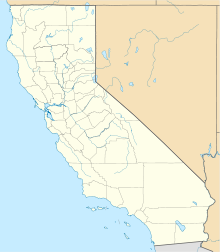
Armour or armor is a covering used to protect an object, individual, or vehicle from physical injury or damage, especially direct contact weapons or projectiles during combat, or from a potentially dangerous environment or activity. Personal armour is used to protect soldiers and war animals. Vehicle armour is used on warships, armoured fighting vehicles, and some mostly ground attack combat aircraft.
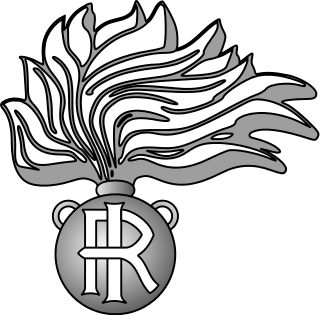
The Carabinieri are the national gendarmerie of Italy who primarily carry out domestic policing duties. It is one of Italy's main law enforcement agencies, alongside the Polizia di Stato and the Guardia di Finanza. As with the Guardia di Finanza but in contrast to the Polizia di Stato, the Carabinieri are a military force. As the fourth branch of the Italian Armed Forces, they come under the authority of the Ministry of Defence; for activities related to inland public order and security, they functionally depend on the Ministry of the Interior. In practice, there is a significant overlap between the jurisdiction of the Polizia di Stato and Carabinieri, although both of them are contactable through 112, the European Union's Single Emergency number. Unlike the Polizia di Stato, the Carabinieri have responsibility for policing the military, and a number of members regularly participate in military missions abroad.

The Sopwith Camel is a British First World War single-seat biplane fighter aircraft that was introduced on the Western Front in 1917. It was developed by the Sopwith Aviation Company as a successor to the Sopwith Pup and became one of the best known fighter aircraft of the Great War.
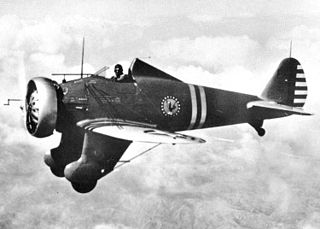
The Boeing P-26 "Peashooter" was the first American production all-metal fighter aircraft and the first pursuit monoplane to enter squadron service with the United States Army Air Corps. Designed and built by Boeing, the prototype first flew in 1932, and the type was still in use with the U.S. Army Air Corps as late as 1941 in the Philippines. There are two surviving Peashooters, but there are three reproductions on display with two more under construction.

The Studebaker National Museum is a museum in South Bend, Indiana, United States that displays a variety of automobiles, wagons, carriages, and military vehicles related to the Studebaker Corporation and other aspects of American history.

The Museum of Military History – Military History Institute in Vienna is the leading museum of the Austrian Armed Forces. It documents the history of Austrian military affairs through a wide range of exhibits comprising, above all, weapons, armours, tanks, aeroplanes, uniforms, flags, paintings, medals and badges of honour, photographs, battleship models, and documents. Although the museum is owned by the Federal Government, it is not affiliated to the Federal museums but is organised as a subordinate agency reporting directly to the Ministry of Defence and Sports.

Istanbul Military Museum is dedicated to one thousand years of Turkish military history. It is one of the leading museums of its kind in the world. The museum is open to the public everyday except Mondays and Tuesdays.
The Hotchkiss M1909 machine gun was a light machine gun of the early 20th century, developed and built by Hotchkiss et Cie. It was also known as the Hotchkiss Mark I, Hotchkiss Portative and M1909 Benét–Mercié.

Military camouflage is the use of camouflage by an armed force to protect personnel and equipment from observation by enemy forces. In practice, this means applying colour and materials to military equipment of all kinds, including vehicles, ships, aircraft, gun positions and battledress, either to conceal it from observation (crypsis), or to make it appear as something else (mimicry). The French slang word camouflage came into common English usage during World War I when the concept of visual deception developed into an essential part of modern military tactics. In that war, long-range artillery and observation from the air combined to expand the field of fire, and camouflage was widely used to decrease the danger of being targeted or to enable surprise. As such, military camouflage is a form of military deception.
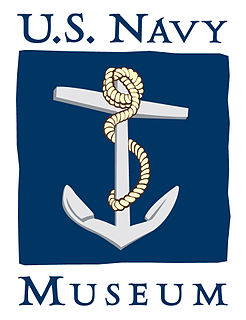
The National Museum of the United States Navy, or U.S. Navy Museum for short, is the flagship museum of the United States Navy and is located in the former Breech Mechanism Shop of the old Naval Gun Factory on the grounds of the Washington Navy Yard in Washington, D.C., United States.

The Military Museum is a museum located in Belgrade, Serbia. Founded in 1878, the museum has over 3,000 ancient and modern items. These include Roman swords and helmets, Greek helmets and daggers, Serbian heavy knight's armor, axes, shields, helmets, crossbows, armoured gloves, as well as Western medieval weapons. There are also more modern guns, firearms, and elements of soldier's uniforms and equipment. Dioramas, plaques, and displays illustrate the use and historical context of the museum's collection.
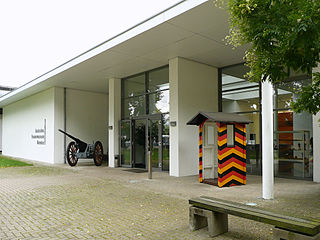
The German Tank Museum is an armoured fighting vehicle museum in Munster, Germany, the location of the Munster Training Area camp. Its main aim is the documentation of the history of German armoured troops since 1917.
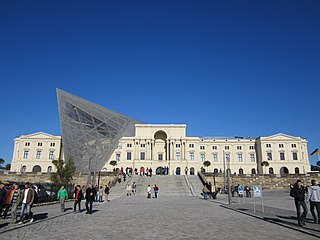
The Bundeswehr Military History Museum is the military museum of the German Armed Forces, the Bundeswehr, and one of the major military history museums in Germany. It is located in a former military arsenal in the Albertstadt which is part of Dresden. After a long history of switching titles and approaches to military history, the museum was re-opened in 2011 with a new internal and external concept. The museum focuses on the human aspects of war, while also showcasing the evolution of German military technology.

The QF 2.95-inch mountain gun was the designation given by the British to a Vickers 75 mm calibre gun. It was originally produced for the Egyptian Army. It was taken into British service in the late 19th century to provide the 'movable armament' at some coaling stations. Also known as 'The Millimetre Gun', it was used by the West African Frontier Force in several theatres in Africa during World War I. It was also used by United States and Philippines.

The 8-inch gun M1 was a 203 mm towed heavy gun developed in the United States. At 32,584 m (35,635 yd), it had the longest range of any US Army field artillery weapon in World War II. It was also used in small numbers by the British Army.
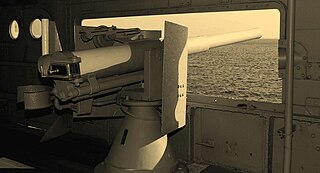
The QF 12-pounder 12-cwt gun was a common, versatile 3-inch (76.2 mm) calibre naval gun introduced in 1894 and used until the middle of the 20th century. It was produced by Armstrong Whitworth, Elswick and used on Royal Navy warships, exported to allied countries, and used for land service. In British service "12-pounder" was the rounded value of the projectile weight, and "12 cwt (hundredweight)" was the weight of the barrel and breech, to differentiate it from other "12-pounder" guns.

The War Museum of Thessaloniki is a military museum in Thessaloniki, Central Macedonia, Greece.

The South African National War Museum in Johannesburg was officially opened by Prime Minister Jan Smuts on 29 August 1947 to preserve the history of South Africa's involvement in the Second World War. In 1975, the museum was renamed the South African National Museum of Military History and its function changed to include all conflicts that South Africa has been involved in. In 1999 it was amalgamated with the Pretoria-based Transvaal Museum and National Cultural History Museum to form the NFI. In April 2010 Ditsong was officially renamed Ditsong Museums of South Africa and the SANMMH was renamed the Ditsong National Museum of Military History.
